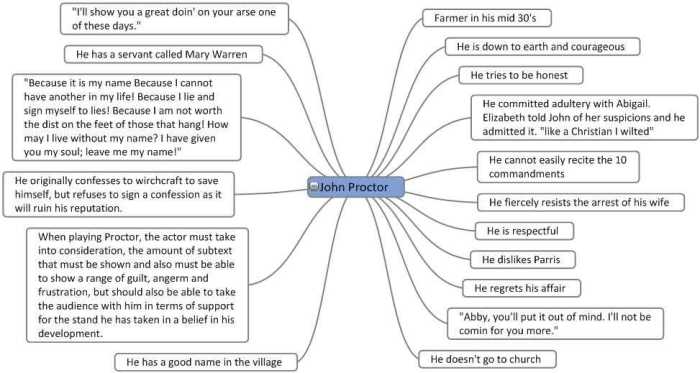The Crucible Act 1 Stage Directions Analysis Worksheet Answers provides a comprehensive guide to understanding the significance of stage directions in Arthur Miller’s iconic play. This analysis delves into the playwright’s meticulous use of setting, atmosphere, and symbolism to create a powerful and evocative theatrical experience.
Miller’s stage directions serve as a blueprint for the play’s production, guiding actors, directors, and designers in realizing the playwright’s vision. By examining these stage directions, we gain insights into the characters’ motivations, the play’s themes, and the overall impact of the production.
Characterization in Act 1

Arthur Miller’s The Crucible delves into the complexities of human nature, particularly during times of mass hysteria and social unrest. Act 1 introduces several key characters who play pivotal roles in the unfolding drama.
Abigail Williams, The crucible act 1 stage directions analysis worksheet answers
- A vengeful and manipulative young woman who falsely accuses others of witchcraft.
- Driven by a desire for power and revenge against John Proctor, with whom she had an affair.
- Her cunning and persuasive nature enables her to sway the community against innocent individuals.
John Proctor
- A respected and influential farmer who initially resists the witch hunt.
- Haunted by his past affair with Abigail, he struggles to maintain his integrity amidst the accusations.
- His courage and moral conscience ultimately lead him to confront the hypocrisy and injustice of the trials.
Reverend Parris
- The ambitious and self-serving minister of Salem.
- His fear of losing his authority and influence motivates him to support the witch hunt.
- His actions contribute to the spread of mass hysteria and the persecution of innocent individuals.
Setting and Atmosphere in Act 1

The setting of Act 1 in The Crucible is a small Puritan community in Salem, Massachusetts, in the late 17th century. This isolated and deeply religious society provides a fertile ground for the witch hunt.
Stage Directions
- Miller’s use of stage directions creates a sense of tension and foreboding from the outset.
- The “ominous music” and “dark and gloomy” atmosphere foreshadow the tragic events that are to come.
- The repeated references to “whispering” and “secrecy” hint at the underlying tensions and suspicions within the community.
The Forest
- The forest on the outskirts of Salem is a symbol of both darkness and temptation.
- It is where Abigail and the other girls engage in forbidden activities, including dancing and witchcraft.
- The forest represents the untamed and dangerous aspects of human nature that threaten the order of the Puritan society.
Conflict and Themes in Act 1

Act 1 of The Crucible introduces several major conflicts that drive the plot forward.
Conflicts
- Abigail’s desire for revenge against John Proctor vs. Proctor’s desire to protect his reputation and family.
- The community’s fear of witchcraft vs. the individual rights of the accused.
- The conflict between the forces of good and evil within the community.
Themes
- Guilt:The characters are haunted by their past actions, which ultimately lead to their downfall.
- Hypocrisy:The Puritan society professes to be righteous but is deeply flawed and hypocritical.
- Mass Hysteria:The community is easily swayed by fear and superstition, leading to the unjust persecution of innocent individuals.
Witch Trials
- The witch trials serve as a metaphor for the dangers of unchecked power and the fragility of human justice.
- They reveal the underlying social and political tensions within the community.
- The trials ultimately expose the true nature of evil and the consequences of mass hysteria.
Foreshadowing and Symbolism in Act 1
Miller uses various techniques of foreshadowing and symbolism in Act 1 to hint at future events and explore the play’s themes.
Foreshadowing
- Abigail’s threat to “make [John Proctor] dance with [her]” foreshadows his eventual arrest and execution.
- The girls’ “fits” and accusations of witchcraft foreshadow the escalation of the witch hunt.
- Reverend Parris’s fear of losing his position foreshadows his willingness to manipulate the situation for his own gain.
Symbolism
- The bird:The bird that Mary Warren brings to Abigail symbolizes the fragility of life and the ease with which innocence can be destroyed.
- The fire:The fire that Abigail sets in the Proctors’ house symbolizes the destructive power of mass hysteria.
- Dreams and visions:The dreams and visions experienced by the characters foreshadow the supernatural elements that will play a role in the play.
FAQ Corner: The Crucible Act 1 Stage Directions Analysis Worksheet Answers
What is the significance of the forest setting in Act 1?
The forest setting in Act 1 symbolizes the wilderness and danger that lurks outside the Puritan community. It is a place where secrets are kept, and where the forces of darkness can take hold.
How do the stage directions contribute to the sense of tension and foreboding in Act 1?
Miller’s use of stage directions in Act 1 creates a sense of tension and foreboding through the use of lighting, sound effects, and movement. The darkness of the forest, the sound of thunder, and the characters’ furtive movements all contribute to the feeling that something sinister is about to happen.
What is the role of dreams and visions in Act 1?
Dreams and visions play a significant role in Act 1, foreshadowing future events and revealing the characters’ inner thoughts and fears. Abigail’s dream of dancing in the forest with Proctor, for example, foreshadows her desire for him and her willingness to use witchcraft to get what she wants.